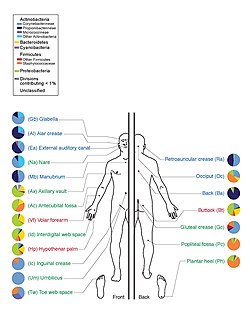ไมโครไบโอมของมนุษย์
หน้าตา
(เปลี่ยนทางจาก Normal flora)
บทความนี้ไม่มีการอ้างอิงจากแหล่งที่มาใด |
บทความนี้ต้องการการจัดหน้า จัดหมวดหมู่ ใส่ลิงก์ภายใน หรือเก็บกวาดเนื้อหา ให้มีคุณภาพดีขึ้น คุณสามารถปรับปรุงแก้ไขบทความนี้ได้ และนำป้ายออก พิจารณาใช้ป้ายข้อความอื่นเพื่อชี้ชัดข้อบกพร่อง |

ในร่างกายมนุษย์มีชุมชนจุลชีพ (ไมโครไบโอตา) อาศัยอยู่เป็นปกติ จุลชีพทั้งหมดในร่างกายมนุษย์คนหนึ่งๆ เรียกรวมว่า ไมโครไบโอมของมนุษย์[1] (อังกฤษ: microbiome, human microbiome) โดยนับรวมทั้งที่อยู่บนผิว ภายในเนื้อเยื่อ หรือในสารคัดหลั่งของอวัยวะต่างๆ ได้แก่ ผิวหนัง ต่อมน้ำนม รก น้ำอสุจิ มดลูก รังไข่ ปอด น้ำลาย เยื่อบุช่องปาก เยื่อบุตา ท่อน้ำดี และทางเดินอาหาร สิ่งมีชีวิตเหล่านี้มีทั้งที่เป็นแบคทีเรีย อาร์เคีย เชื้อรา โปรติสต์ และไวรัส นอกจากนี้ยังอาจมีสัตว์ขนาดเล็กอาศัยอยู่ในร่างกายมนุษย์ แต่มักไม่นับรวมเป็นส่วนหนึ่งของไมโครไบโอม บางครั้งอาจมีการใช้คำว่า "ไมโครไบโอม" ในอีกความหมายหนึ่ง คือหมายถึงพันธุกรรมรวมทั้งหมด หรือ จีโนม ของทั้งมนุษย์และสิ่งมีชีวิตขนาดเล็กเหล่านี้รวมกัน[2] อีกคำหนึ่งที่มีความหมายเดียวกันคือ human metagenome[1]
อ้างอิง
[แก้]- ↑ 1.0 1.1 Marchesi JR, Ravel J (2015). "The vocabulary of microbiome research: a proposal". Microbiome. 3: 31. doi:10.1186/s40168-015-0094-5. PMC 4520061. PMID 26229597.
Microbiome
This term refers to the entire habitat, including the microorganisms (bacteria, archaea, lower and higher eurkaryotes, and viruses), their genomes (i.e., genes), and the surrounding environmental conditions. This definition is based on that of “biome,” the biotic and abiotic factors of given environments. Others in the field limit the definition of microbiome to the collection of genes and genomes of members of a microbiota. It is argued that this is the definition of metagenome, which combined with the environment constitutes the microbiome. - ↑ Sherwood, Linda; Willey, Joanne; Woolverton, Christopher (2013). Prescott's Microbiology (9th ed.). New York: McGraw Hill. pp. 713–721. ISBN 9780073402406. OCLC 886600661.
